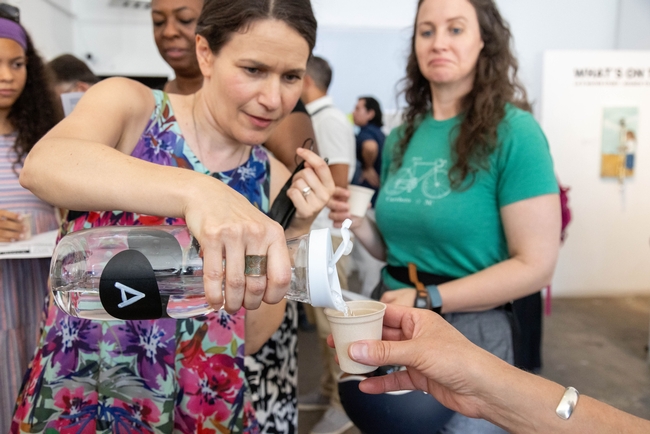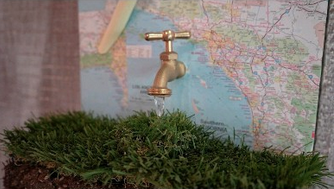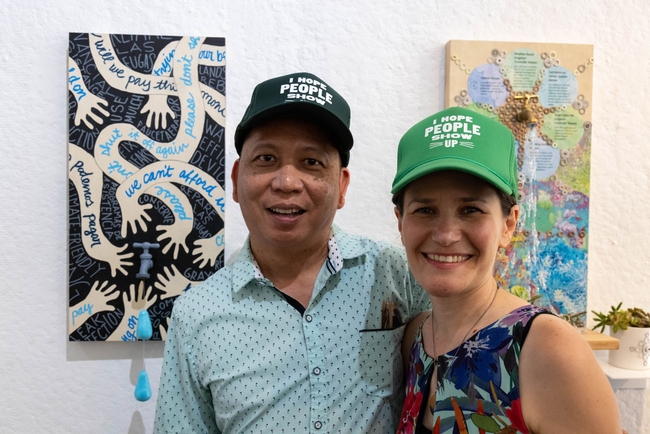Posts Tagged: Water
Water discussion on Sept. 29 flows from LA art exhibit
Communities in Los Angeles and around California face a variety of water challenges ranging from access to clean, affordable water to water supplies threatened by a changing climate.
The public is invited to a free event featuring a panel discussion of the past, present and future of Los Angeles water. The water discussion will be part of the closing reception for the art exhibit “What's On Tap: LA's Water Story…Source to Spigot” at El Tranquilo Gallery in Los Angeles on Sunday, Sept. 29.
“I hope that people come away understanding that our relationship to and stewardship of water in LA is not only a critical part of our past history, but essential to determining our region's future as well,” said Edith B. de Guzman, UC Cooperative Extension specialist for water equity and adaptation policy with UC Agriculture and Natural Resources and UCLA Luskin Center for Innovation.
The panel will be moderated by UCLA Public Policy Professor Megan Mullin. Panelists will include de Guzman; Amanda Begley, watershed senior program manager for TreePeople; Conner Everts, facilitator for the Environmental Water Caucus, executive director of the Southern California Watershed Alliance, and co-chair of the Desal Response Group; and Mark Gold, director of water scarcity solutions for the Natural Resources Defense Council.
The discussion will be followed by a blind water tasting. Participants will be able to taste how the flavors of three brands of bottled water compare with each other and Los Angeles Department of Water and Power tap water.
“Thus far, many people have chosen LADWP tap as their favorite compared to the bottled brands,” de Guzman said. “So another hope I have is that people will come away with greater appreciation and trust of tap water.”
The art exhibit, curated by Edith and Jolly de Guzman, highlights five distinct water themes that affect Southern California communities – local water, imported water, tap trust, human right to water and affordability.
The Zanja Madre, a Spanish-era aqueduct that moved water from the Los Angeles River to the pueblo of Los Angeles between 1781 and 1904, once ran past the gallery location.
The “What's On Tap: LA's Water Story…Source to Spigot” exhibit will be open from 11 a.m.-3 p.m. Friday through Sunday, Sept. 27-29, with the closing reception 3-6 p.m. on Sunday, at El Tranquilo Gallery, W-19 Olvera Street, Los Angeles 90012. The panel discussion will begin at 4 p.m. The reception will include live music by Shoshana Ben-Horin.
UCCE offers water measurement training Sept. 13 in Salinas
California water-rights holders are required by state law to measure and report the water they divert from surface streams. For people who wish to take the water measurements themselves, the University of California Cooperative Extension is offering in-person training to receive certification on Sept. 13 in Salinas.
At the workshop, participants can expect to
- clarify reporting requirements for ranches.
- understand what meters are appropriate for different situations.
- learn how to determine measurement equipment accuracy.
- develop an understanding of measurement weirs.
- learn how to calculate and report volume from flow data.
The training is scheduled for 1 to 5 p.m. on Sept. 13 in the UC Cooperative Extension Conference Room at 1432 Abbott Street in Salinas.
"We are limiting the number participants for the water measurement training to 30 people per session," said Larry Forero, emeritus UC Cooperative Extension livestock and natural resources advisor. "If you need this training, please register soon."
Pre-registration is required and the fee is $30. To register, visit the registration site by clicking here. If you have questions, email Forero at lcforero@ucanr.edu or Sara Jaimes at sbjaimes@ucanr.edu or call (530) 224-4900.
Background:
Senate Bill 88 requires that all water right holders who have previously diverted, or intend to divert, more than 10 acre-feet per year (riparian and pre-1914 claims); or who are authorized to divert more than 10 acre-feet per year under a permit, license or registration; to measure and report the water they divert. Regulatory requirements for measurement and reporting are available on the State Water Resources Control Board Reporting and Measurement Regulation webpage. The legislation requires that installation and certification of measurement methods for diversion (or storage) greater than or equal to 100-acre feet annually be approved by an engineer/contractor/professional.
California Cattlemen's Association worked with Assemblyman Bigelow to allow a self-certification option. Assembly Bill 589, which became law in 2018, allows any water diverter who completes this UC Cooperative Extension course on measurement devices and methods (including passage of a proficiency test) to be considered a qualified individual when installing and maintaining devices or implementing methods of measurement.
Hands-on learning, training make irrigation best practices accessible
UCCE advisors provide free training to nursery and greenhouse staff
Working as an irrigator seems straightforward at first: if you're not watering plants by hand, you're building and managing systems that can do the watering. What could be complex about a job like this?
University of California Cooperative Extension advisors Bruno Pitton and Gerardo “Gerry” Spinelli can tell you – or better yet, show you.
Pitton and Spinelli, members of the UC Nursery and Floriculture Alliance, offer a one-day technical training in irrigation best-management practices for irrigators working with containerized nursery plants. The comprehensive curriculum – developed with input from two focus groups of California nursery and greenhouse managers – aims to improve irrigation efficiency, reduce water consumption and improve plant health.
Thanks to funding from the California Department of Food and Agriculture, nursery and greenhouse managers in California can request this training for free and advisors like Pitton and Spinelli will travel to conduct the training on-site.
The complexities of irrigation incorporate concepts like evapotranspiration, salinity, irrigation uniformity, capillarity, pressure and flow rate. Spinelli, UCCE production horticulture advisor for San Diego County, said that irrigators have a critical role in the industry because of all the things they must consider to do their job well.
“Our goal is to support irrigators and help them become more confident decision-makers and experts in the field,” said Pitton, UCCE environmental horticulture advisor for Placer and Nevada counties.
Interactive sessions reveal nuances of irrigation
The training consists of a presentation on fundamental concepts for managing irrigation in container plant production and hands-on demonstrations. “In the nursery industry, where precise irrigation is crucial for the health and productivity of our crops, having access to expert knowledge is invaluable,” said Mauricio de Almeida, general manager of Burchell Nursery in Fresno County. “The training's practical demonstrations and real-world examples made the concepts easy to grasp, allowing our team to implement the strategies immediately.”
For one of the demonstrations, the advisors used sponges to model soil saturation when water is applied. Ana, an irrigator at Burchell Nursery, appreciated the step-by-step explanations, which helped her better understand how water pressure differs in drip irrigation, sprinklers and watering by hand. Doing this out in the field, as an example of how irrigation audits occur, was extremely helpful for attendees.
Francisco “Frank” Anguiano, production manager of Boething Treeland Farms in Ventura County, observed his team of irrigators as they learned how to measure distribution uniformity with water collected from sprinklers. “This training isn't just about irrigation and plant management. It's also about savings, both water and costs. Who doesn't want to save money and use less water?” Anguiano said.
Reducing the barriers to learning
Many of the irrigators attending these trainings gained their skills and knowledge from life experience rather than a college education, explained Peter van Horenbeeck, vice president of Boething Treeland Farms. “It's important that my irrigators learn from external experts, but it's more important that they can relate to them. And that's what Gerry was able to do,” van Horenbeeck added.
Regarding content and delivery, and referencing what he learned from the focus groups, Pitton wanted the trainings to be easy to understand and engaging. For example, scientists use the term “matric potential” to describe how soil particles hold water against gravity, which is the same as capillary rise. “We demonstrate this concept with a paper towel held vertically and dipped into a beaker of dyed water that it absorbs,” said Pitton.
Many of the irrigators in attendance agreed that hands-on activities and visual aids were instrumental to their learning. Charli, another irrigator at Burchell Nursery, shared that the in-field examples and hosting the training in Spanish kept them engaged.To address language barriers, Spinelli has been conducting trainings in Spanish – a common request from many nurseries with eager participants.
Maintaining state regulations and partnerships
Although the technical aspects of irrigation management are key elements of the training, regulatory compliance is also addressed. Recognizing the finite availability of water and the environmental impact of pollution, the advisors highlight irrigation and fertilizer management and runoff prevention as critical components of compliance.
Under Ag Order 4.0 administered by California's Water Resources Control Board, growers must comply with stricter policies regulating nitrogen use. As irrigators learn from the training, better control of irrigation can certainly make a difference.
Deanna van Klaveren, chief operating officer and co-owner of Generation Growers in Stanislaus County, said the most valuable aspect of the training was learning on-site and completing an audit on her own systems. “It is so much more impactful to have trainings like this on-site where our staff can learn and then go out into the nursery and actually put it into practice while the presenters/experts are there,” van Klaveren said.
Pitton and Spinelli described the partnership between UC Cooperative Extension and CDFA as “symbiotic” given the technical and educational capacity of UCCE advisors who conduct research and extension.
“It's a great example of how the two institutions can collaborate successfully. Californians are the ones who win because they get a service for free,” added Spinelli. “And it's rewarding for us to see so much interest in what we, as advisors, do.”
If you are a nursery or greenhouse operator and would like to request the Irrigation Best Management Practices training, please contact the UCCE advisor assigned to the region that corresponds with your nursery location below.
Northern California
- Jessie Godfrey, UCCE environmental horticulture and water resources management advisor, jmgodfrey@ucanr.edu
Central Coast (Santa Cruz County to Ventura County)
- Emma Volk, UCCE production horticulture advisor, evolk@ucanr.edu
San Joaquin Valley
- Chris Shogren, UCCE environmental horticulture advisor, cjshogren@ucanr.edu
Southern California
- Grant Johnson, UCCE urban agriculture technology advisor, gejohnson@ucanr.edu
Spanish Trainings Only
- Gerry Spinelli, UCCE production horticulture advisor, gspinelli@ucanr.edu
UCCE offers water measurement training Sept. 13 in Salinas
California water-rights holders are required by state law to measure and report the water they divert from surface streams. For people who wish to take the water measurements themselves, the University of California Cooperative Extension is offering in-person training to receive certification on Sept. 13 in Salinas.
At the workshop, participants can expect to
- clarify reporting requirements for ranches.
- understand what meters are appropriate for different situations.
- learn how to determine measurement equipment accuracy.
- develop an understanding of measurement weirs.
- learn how to calculate and report volume from flow data.
The training is scheduled for 1 to 5 p.m. on Sept. 13 in the UC Cooperative Extension Conference Room at 1432 Abbott Street in Salinas.
“We are limiting the number participants for the water measurement training to 30 people per session,” said Larry Forero, emeritus UC Cooperative Extension livestock and natural resources advisor. “If you need this training, please register soon.”
Pre-registration is required and the fee is $30. To register, visit https://surveys.ucanr.edu/survey.cfm?surveynumber=43495. If you have questions, email Forero at lcforero@ucanr.edu or Sara Jaimes at sbjaimes@ucanr.edu, or call (530) 224-4900.
New UC Report on Water
Bold moves needed for California agriculture to adapt to climate change
University of California report details farming's needs for climate resilience
California should take urgent and bold measures to adapt its $59 billion agriculture sector to climate change as the amount of water available for crops declines, according to a collaborative report by University of California faculty from four campuses.
Published in the Proceedings of the National Academy of Sciences, the report provides a roadmap for more water capture, storage, and distribution systems that are in harmony with climate projections and ecosystems. It further considers how runoff and groundwater can be used repeatedly as it flows generally from mountainsides to coastal lands.
“The availability of water for consumption is decreasing because of climate change, partly due to increased evaporation and transpiration but also because we don't have the system set up to capture and use the larger and more variable flows that are now the norm,” said Kurt Schwabe, a public policy professor at UC Riverside and co-author of the report.
A warmer planet means fewer but larger rain and snowstorms in California. The rising temperatures and shorter winters also result in smaller volumes of water stored in mountain snowpacks that have historically replenished California's reservoirs each spring. And a greater amount of water is getting lost through evaporation.
This means that agriculture, which uses about 80 percent of the water consumed in the state, will need to adjust to a future with less water available for irrigation.
To help reduce the overall impact on agriculture and society from climate change, the report's authors envision a more nimble and responsive system that can capture and store water from big storms before it goes to sea to prevent floods and keep crops growing through the hot, dry summer months.
To do so, California must increase its water storage capacity, but that doesn't necessarily require building more dams and reservoirs, Schwabe said. Great storage capacity now exists in the state's depleted aquifers below the Central Valley and the coastal plains.
“It's really a huge win,” Schwabe said. “We can start taking more of those flood flows, and unexpected overflows, and put them in these groundwater aquifers. We've got plenty of capacity there, and you don't suffer from the evaporation rates that you do with the surface reservoirs.”
Capturing the flows would involve diverting torrents from heavy rains and accelerated snowmelts to farm fields or to habitat lands where controlled flooding would cause no harm, and the water would percolate down to aquifers. Farmers would then have more groundwater to get through drier periods while also reviving wildlife habitats.
Farmers also should take advantage of new crop varieties, so they have more flexibility to deal with different water situations. Changing crops, unlike changing irrigation systems, is a practice that can lead to reduced overall water use.
“It's obviously an economic decision confronting the growers,” Schwabe said.
However, switching from a water-intensive practice such as flood irrigation to something like drip irrigation, doesn't necessarily save much water at the system level, he said. Flood irrigation may be appropriate if it helps recharge aquifers, or the runoff is used again by other farms.
“Sometimes the runoff water appears later in the system for use,” Schwabe said
California also needs to build more flexibility into its water delivery systems. The state's three major aqueducts — the California State Water Project, the Central Valley Project, and the Colorado River Aqueduct — for the most part transport water from north to south. A greater ability to move water from east to west and vice versa would allow for more efficient water use. Farmers who have more water than they need for a particular season could sell to others in need. With prices based on scarcity plus delivery costs, such a marketplace would have incentives for storage and efficient use, Schwabe said.
The report's title is “Cultivating Climate Resilience in California Agriculture: Adaptations to an Increasingly Volatile Water Future.”
In addition to Schwabe, the report's co-authors are Josué Medellín-Azuar at UC Merced, Alvar Escriva-Bou at UCLA, and Amélie Gaudin and Daniel Sumner at UC Davis.
“When I moved to California over 20 years ago, someone told me, “Don't let people tell you there isn't a lot of water in California because there is. The problem is that it's just managed really poorly,” Schwabe said.
That said, Schwabe believes the state is making progress by developing policies that can lead to more efficient and sustainable outcomes, such as the Sustainable Groundwater Management Act of 2014.
“Today more than ever before we're seeing partnerships across environmental, agricultural, and municipal sectors to address water scarcity issues,” Schwabe said. “And that's a good thing.”

waterfall










